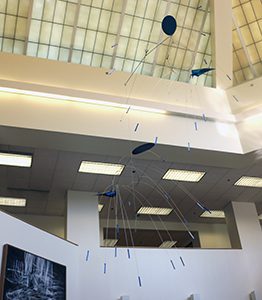Spotlight: Artist enhances Hayes Hall atrium with a three-piece mobile
The latest installation of art at Indiana University East continues to add beauty and prompt discussion on campus.
The new three-piece work viewed by daily passersby is a colorful mobile installation called “Blue Madonnas.”
Terry Welker, an architect/artist living in Kettering, Ohio, created the attractive work that was originally called “Blue Birds.” It is now known as “Blue Madonnas” because the artist added small birds to the middle (womb) of each piece.
“I’m not trying to mimic nature – I’m responding to my memory of nature,” Welker said, noting the birds are fairly abstract.
Students, staff and faculty say they’ve enjoyed the addition of the colorful art.
“The new mobile art in the Hayes Hall entryway has added a positive dimension to the learning environment,” said Karen Clark.
Clark spends time at Hayes Hall as dean of the School of Nursing and Health Sciences and an associate professor of nursing at IU East.
“Faculty, staff, and students have commented on how the art enhances the space, filling it with an aesthetically pleasing design that stimulates conversation and promotes a sense of relaxation,” she said.
Ed Thornburg was inspired to seek out some art for the Hayes Hall entryway in 2016. He serves as campus art director and director/curator of the fine arts art galleries.
“While in Hayes Hall, looking at the well-lit entry and foyer areas, for some reason I wished there was a central art piece to warm up the angular and linear spaces,” he said. “Terry Welker’s animated and colorful mobiles came to mind.”
Thornburg already was familiar with Welker’s work after coordinating his exhibit at IU East in 2015. That show developed after Thornburg met Welker at an exhibit in Dayton, Ohio, in 2013. They exchanged business cards, and Welker’s card sat in Thornburg’s file for a few months until he started to investigate his art.
Thornburg said he made some serious contact with Welker regarding a possible exhibit on campus. Although Welker was quite busy with ongoing works in various parts of the United States and Mexico, he made the trip to Richmond to meet Thornburg and see the gallery spaces.
After seeing the open space of the Tom Thomas Gallery, Thornburg said Welker was excited to explore the possibilities of an interactive / inclusive installation. Over the course of several months, he created “The Consent,” a ginkgo-themed show. He filled the entire space with related text and poetry in May 2015. Thornburg calls “The Consent” a “beautiful and creative show,” saying it attracted a great deal of interest and attention by campus and area visitors.
During the next year, Thornburg was inspired to propose more art in Hayes Hall. Welker said his background as an architect and sculptor helped as he looked at the composition of the space to create something that ties the Hayes Hall areas together.
A lot of Welker’s approach to art depends on size and scale. He said the mobiles must be intentionally large so the scale is right.
The final size of the large work is approximately 11 feet wide by 10 feet tall, and it rotates 360 degrees.
“If it would be any smaller, it would get lost,” he said.
The companion piece is 7 feet tall by 8 feet wide by 5 feet deep.
Being careful with the skylight, Welker worked with the university’s architect to add cables that could be concealed to help display “Blue Madonnas.”
When the air pressure changes, such as the opening of Hayes Hall’s exterior doors or the air conditioning kicks on, the mobile will start to subtly move.
“I’m letting gravity do its job,” he said.
Making these mobiles takes Welker a great deal of time and coordination. He gets his wire custom-bent to his specifications on a vendor’s special machines. He also uses special dye that is heated to 145 degrees to get the rich blue color, comparing the process to dyeing Easter eggs.
He said he was highly honored and pleased that IU East wanted to add his works to its permanent collection, noting that art can make a big difference in the environment to create a sense of place.
“The campus is going in the right direction,” he said.
Welker said he enjoyed interacting with students and staff while installing the art and found it rewarding to give a lecture to one of Assistant Professor Carrie Longley’s classes. Longley is also the department chair of IU East’s Fine Arts program.
Teaching is nothing new to Welker, who began his formal education in fine art at Wright State University, but later moved toward architecture. After completing his graduate work as a Wolfson Fellow at the University of Cincinnati in 1987, he continued teaching design and drawing at UC for several years.
An award-winning architect, he opened his own office in 1994 and created the Archetype Gallery serving artists of the Miami Valley. He’s a Fellow of the American Institute of Architects, with only about 3 percent of members being part of this distinguished group. Welker says his teaching background, gallery experience, and architectural knowledge in design and structure all inform his work as a sculptor.
Welker is still a practicing architect, but said “my nights, weekends and vacations are dedicated to art.”
He juggles several art projects at the same time. Some of his works can be found at sites ranging from Nationwide Children’s Hospital in Columbus, Ohio, to the Dayton Metro Library Main Branch, where he installed “Fractal Rain” this year.


